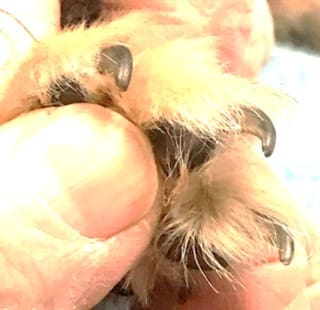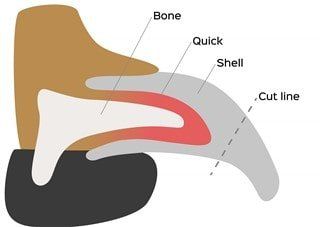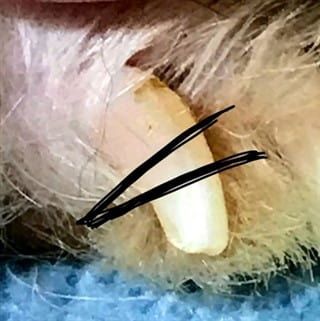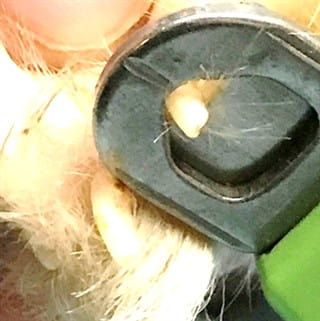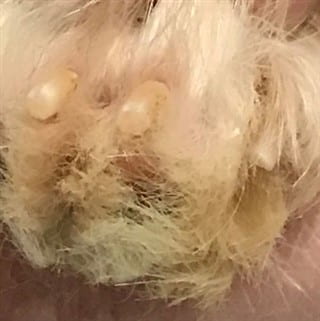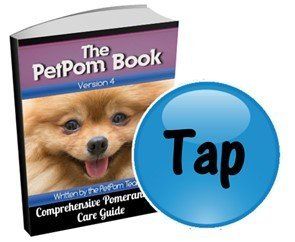Pomeranian Nail Care
Overview
Pomeranians can have light or dark nails. And, nails grow at varying rates. You’ll want to keep an eye on your Pom's nails to check for any issues and trim them on a regular basis. Long nails can inadvertently scratch you, get caught on carpets and other fabrics, become ingrown (which can be quite painful), grow unevenly which can throw off a dog’s natural gait, or split or crack.
Please note:
PetPom is reader-supported, and some of the product suggestions on this page are affiliate links. As an Amazon Associate we earn from qualifying purchases. This is at no extra cost to you and helps us continue providing free, high-quality information.
How Often a Pomeranian's Nails Need to Be Trimmed
Nails grow at varying rates and can be naturally filed down to some degree from walking on certain rough surfaces (like concrete or pavement), though not usually enough to completely eliminate the need for being cut. In general, a Pomeranian requires their nails to be trimmed every 6 weeks, but this can be as often as every 4 weeks or not necessary until every 8 weeks or so.
It's best to visually inspect the nails often to check on their length so that they can be trimmed on time. Once you see an obvious curl, it's time to cut them. Another way to know that the nails need trimming is that you'll hear the characteristic ‘click-clack’ sound when your Pom walks over hard flooring surfaces.
These nails are long and curved and in need of a trim.
Trimming Nails at Home vs. the Groomer
It's common for dogs to have trouble staying still when their nails are trimmed. And if a nail is accidentally cut down too short, it can nick the 'quick', which is a blood vessel and nerve running down the center of each nail; if so, it can bleed quite profusely and it can be very painful (but there is a first-aid solution you can apply; more ahead). For these reasons, many owners prefer to leave nail trimming to a professional. Though vet offices sometimes offer this service, dog groomers are the most popular choice. The cost for this in the U.S. can run between $10 and $25.
This said, if you take your time and carefully follow instructions, you can certainly learn to trim your Pomeranian's nails at home in a safe manner. It's very similar to clipping your own nails or your children's nails (though a dog's nails are much thicker and will require a special tool). And with just a bit of practice, you can quickly become a pro. The more you do this, the more desensitized your Pom will become to it, and they can learn to stay calm and behave nicely during this grooming task.
Nail Clipping Tool Options
There are two main types of tools:
1. A manual dog nail clipper. This is a hand-held tool that is the pet equivalent of human nail clippers. There are small ones that are akin to scissors and larger ones that are a bit more heavy-duty. If it's a quality clipper with sharp blades and a comfortable grip, it can be quick and easy to use.
2. An electric nail grinder. Grinders are portable hand-held battery-operated or plug-in electronic filers that can quickly file nails down. The pros are that it can be quick and less invasive than clippers but the cons are that these can be very noisy which can spook a dog and the file can work a bit too fast.
Recommended Tools
Please note that we prefer manual clippers, but if you have a strong preference, you should opt for whatever you feel most comfortable using.
For Pomeranian puppies and most adults
(10 lbs. and under), nail scissors like the Pet Nail Clippers for Small Animals by Shiny Pet
 can be a good choice since this type of tool is easy to use on tiny nails (it works for cats and other small pets too). These particular ones are angled 20 degrees which allows you to see the nails as you are clipping them and have rubberized non-slip handles for a comfortable and safe grip.
can be a good choice since this type of tool is easy to use on tiny nails (it works for cats and other small pets too). These particular ones are angled 20 degrees which allows you to see the nails as you are clipping them and have rubberized non-slip handles for a comfortable and safe grip.
For larger adult Pomeranians
(over 10 pounds), a larger clipper is recommended such as the Gonicc Pets Nail Clippers . This has stainless-steel blades and a stop-guard which helps prevent cutting nails too short.
. This has stainless-steel blades and a stop-guard which helps prevent cutting nails too short.
How to Trim a Pomeranian's Nails
Supplies to have:
1. Your tool of choice (see above options
which includes electric filers, scissor trimmers, and metal clippers).
2. Miracle Care Kwik-Stop Styptic Gel
 (or another similar product). This is a first aid gel (which stays on better than a powder) that should be immediately applied if a nail is cut too short. It is designed to quickly stop bleeding and this particular one contains benzocaine which is a topical anesthetic (numbing medication) to help offer relief.
(or another similar product). This is a first aid gel (which stays on better than a powder) that should be immediately applied if a nail is cut too short. It is designed to quickly stop bleeding and this particular one contains benzocaine which is a topical anesthetic (numbing medication) to help offer relief.
Knowing How Short to Cut the Nails
The length that a Pomeranian's nails should be trimmed down to is all based on where the 'quick' is located. As described earlier, the quick is a blood vessel and nerve that runs down the center of each nail. It does not extend to the very tip of the nails.
With Poms that have light-colored nails, you can sometimes see the quick through the nail (it will appear pink or red). With Poms that have dark or black nails, you will not be able to see it through the nail, but as you cut and look at the nail straight on, you may see a tiny pink or red dot letting you know that you are getting close, at which time you should stop cutting.
Taking a look at the image below, you will see where the quick is located within the nail and where the cut line should be.
Step-by-step Instructions:
#1.
One at a time, take a close look at each nail so that you feel confident where the cut line is. Stay a little to the long side of the 'nail hook' (the area where the nail begins to curl).
#2.
Be sure you have a good grip on the clippers. Put it into position. If the tool you are using has a 'stop' or a guide, be sure to use it. Use a firm and quick squeeze to clip the nail. The nail should easily cut.
#3.
Check the nails to be sure that you cut them short enough (but, of course, not too short). The photo below shows how the nails should look after being trimmed. Filing them afterwards is an option; grooming salons file nails to create a super-smooth finish, but many owners skip over this step at home.
Helping a Pom Become Desensitized to Nail Trims
Some dogs really dislike having their nails trimmed; maybe you've seen some funny videos of dogs pretending to faint as the clipper comes close to their nails. We really can't blame our Poms for disliking this task, especially if they've had a nail quick cut into in the past, since it can be very painful.
But this is not to say that it's not worth your time trying to help your Pom get used to nail trimmings. Sometimes all it takes is a bit of practice and a few sessions that go well for a puppy or dog to learn to be okay with it.
The goal will be to have short sessions in which nails are touched in increasing degrees, starting with just your fingers and working up to actual clipping. The sessions should end on a good note (while your Pom is calm) and with tons of praise and a training treat reward (to reinforce the idea that sitting still for the task brings about good things).
Begin with just 1 to 2 minutes of having your Pom lie on their side, with you holding their paw and touching their nails with your fingertips. You can sing a little melody or speak to them in a matter-of-fact voice. End things while your Pom is still patient, using happy words of praise and by palming over a training treat.
After a few sessions, move up to holding the clippers in your hand and bringing them to the nails but not clipping. After a few more successful sessions, go one step further by lining nails up on the clipper. Finally, graduate to clipping the nails. If you are not yet fast with the clippers and your Pom gets restless, you may want to do half of the nails one day and the other half the next.
If your Pomeranian just cannot sit still, which can make trimming the nails very difficult, consider having a trusted groomer do this task.
A Note About Dewclaws
Dewclaws, which are just a small nail (on puppies) and a 5th toe with a nail (on adult Pomeranians) are mainly seen on the front paws (and once in a while on both front and back) on Poms that have not had dewclaws removed as young pups. These should be trimmed at the same time the other nails are done.
Read more about Dewclaws on Pomeranians.
Dry Brittle Nails
If a Pomeranian has dry, brittle nails which can split and crack very easily, this should be addressed right away.
Nails that are dry, weak, and brittle are most often linked to nutritional deficiencies. An increase in omega fatty acids (EPA and DHA) can improve the health and strength of a dog’s nails (and coat). You can add some fresh fish to your Pom’s meals (cold-water fish like salmon and mackerel are best) or add a dash of fish oil like Zesty Paws Pure Wild Alaskan Salmon Oil
 to meals.
to meals.
Another supplement that is great for nails (and coats) health is biotin. Some foods that contain good levels of biotin (and are safe for dogs to eat) include egg yolks, salmon, sweet potato, and cauliflower (just 1 or 2 florets a day since large amounts can make a dog gassy). If you want to give your Pom a supplement, there are chewables and powders like Nickers Bio Coat Concentrated Biotin Supplement
 that you mix into meals.
that you mix into meals.
It can 2 months or so for nails to show significant improvement as it is only the new growth that will be stronger. If there is no improvement, or if brittleness is severe, this warrants a vet visit. While rare, there are some health conditions that can cause nail issues including autoimmune diseases and endocrine disorders.
Itchy, Irritated Nail Beds
There are several reasons why a Pomeranian may have intense itching around the nails which leads them to chew, bite, or lick at their nails and surrounding areas.
One of the most common causes is a reaction to allergens or irritants. Often this is a contact allergy or reaction (something the paws are coming into contact with). Triggers include lawn care chemicals, road salt, ice melt products, and grasses or pollens. Using a paw wax like Musher's Secret Pet Paw Protection Wax
 once a week to create a barrier and rinsing the paws off after being outside can help (an outdoor hose or indoor sink, depending on the weather).
once a week to create a barrier and rinsing the paws off after being outside can help (an outdoor hose or indoor sink, depending on the weather).
It's also worth looking into other types of allergies which could be at the root of the problem, such as reactions to airborne allergens or even to food ingredients.
If your Pom has severe itching
and particularly if they chew or bite at the entire paw, there are other steps that can be taken such as using an anti-itch spray for immediate relief and looking at the possibility of other causes including a fungus/skin yeast infection.
Note that if the there is no improvement when using at-home remedies or if symptoms are severe, this warrants a vet visit.
You May Also Like:
Top Pomerananian Dos and Don'ts
- A helpful look at the 5 most important dos and the 5 most vital don'ts for optimal health and well-being.
Foods a Pomeranian Can and Cannot Eat
- If you're interested in home cooking or just looking for some wholesome snacks, see a complete list of safe and unsafe foods.
How to Keep a Pomeranian Safe
- The top 15 ways to keep your Pom super safe. How many are you doing?
Pomeranian is Scared of Loud Noises
- From thunder to fireworks and even the vacuum cleaner, some dogs are terribly afraid of loud sounds; learn why this is and exactly how to help your little guy or gal.
How to Keep a Pom's Coat Beautiful
- What you can do to keep your Pomeranian's coat soft, shiny, and super-healthy.
How to Fix Tear Stains on a Pomeranian
- If your Pom has discoloration under or around the eyes, it'll take a bit of work but these can be fully removed.


